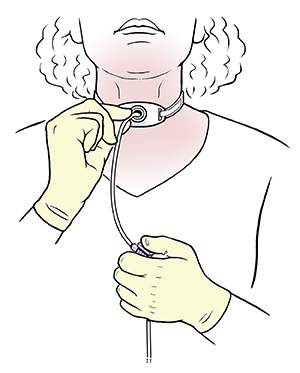Suctioning Your Tracheostomy
Suctioning Your Tracheostomy
Call 911 right away if you ever have trouble breathing.

1. Collect your supplies
Find a clean, well-lighted space near a sink and mirror. Collect your supplies: a suction machine, a clean suction catheter, and a small bowl of distilled water.
Wash your hands with soap and warm water. Then, put on clean, disposable, powderless gloves.
2. Prepare to suction
Turn on the suction machine to _________ mm Hg.
Attach the suction catheter to the suction machine. Dip the catheter tip into the distilled water to assure the suction is working.
Do the following only if your healthcare provider tells you to: Put a small amount of sterile saline solution into your trach tube. This will help loosen mucus.
3. Insert the catheter
Take a few deep breaths to fill your lungs with oxygen.
Gently insert the catheter into your trach tube. While you insert the catheter, do not suction. Stop inserting the catheter when you start to cough.
4. Apply suction
Apply suction. At the same time, slowly pull the catheter out of your trach tube. Move the catheter tip in a circle as you pull the catheter out.
The catheter should be out of your trach tube within 5 to 10 seconds. If you need to suction more, relax and breathe for a few minutes before you start again.
When you have finished suctioning, turn off the suction machine. Discard the used catheter, water, and gloves.
Updated:
August 07, 2018
Sources:
Endotracheal Suctioning of Mechanically Ventilated Patients With Artificial Airways 2010. American Association for Respiratory Care. Respiratory Care. 2010, is. 55, ed. 6, pp. s758-64., Overview of Tracheostomy. UpToDate., Tracheostomy Care: An Evidence-Based Guide to Suctioning and Dressing Changes. B. Nance-Floyd. American Nurse Today. 2011;6(7):14-16.
Reviewed By:
Fetterman, Anne, RN, BSN,Image reviewed by StayWell medical illustration team.,Mancini, Mary, MD